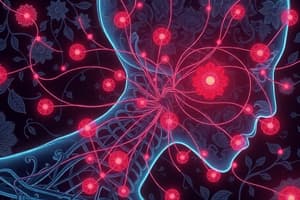Podcast
Questions and Answers
What type of nerve endings are responsible for pain sensation?
What type of nerve endings are responsible for pain sensation?
- Free nerve endings (correct)
- Ganglion cells
- Encapsulated receptors
- Myelinated axons
Which of the following is NOT a benefit of pain sensation?
Which of the following is NOT a benefit of pain sensation?
- Prevents further damage
- Encourages rest for healing
- Enhances physical activity (correct)
- Warning signal about a problem
What phenomenon describes the increased sensitivity of pain receptors over time?
What phenomenon describes the increased sensitivity of pain receptors over time?
- Hyperalgesia (correct)
- Hypoesthesia
- Analgesia
- Allodynia
Which statement about the localization of pain stimuli is true?
Which statement about the localization of pain stimuli is true?
Which emotional reaction may occur due to severe pain?
Which emotional reaction may occur due to severe pain?
Which type of pain is characterized by a delayed increase in intensity over time?
Which type of pain is characterized by a delayed increase in intensity over time?
Which type of fiber transmits fast, well-localized pain?
Which type of fiber transmits fast, well-localized pain?
What kind of pain is described as dull, diffuse, and prolonged, often linked with autonomic symptoms?
What kind of pain is described as dull, diffuse, and prolonged, often linked with autonomic symptoms?
What neurotransmitter is released by A delta fibers in cutaneous pain?
What neurotransmitter is released by A delta fibers in cutaneous pain?
Which pathway is responsible for transmitting pain sensations from the skin to the brain?
Which pathway is responsible for transmitting pain sensations from the skin to the brain?
Flashcards are hidden until you start studying
Study Notes
Pain Overview
- Pain is an unpleasant sensation triggered by harmful stimuli affecting sensory nerve endings, indicating actual or potential damage.
- Nociceptors, free nerve endings, are responsible for pain sensation.
Benefits of Pain Sensation
- Acts as a warning signal for existing issues or threats.
- Initiates withdrawal reflex to prevent further injury.
- Encourages rest and reduces activity for quicker healing.
- Prompts necessary medical intervention to avert serious damage.
Properties of Pain Sensation
- Pain receptors are distributed widely and are primarily free nerve endings.
- Various stimuli can generate pain, including mechanical, chemical, and thermal.
- Localization of pain is less precise than other sensory modalities, often resulting in referred pain.
- Pain receptors show little adaptation; sensitivity may increase over time (hyperalgesia).
- Certain body areas, such as brain tissue and lung alveoli, are insensitive to pain.
Effects Associated with Pain
- Motor Reactions: Withdrawal reflex, muscle rigidity.
- Autonomic Reactions: Mild pain causes tachycardia and elevated blood pressure; severe pain can lead to bradycardia and decreased blood pressure.
- Emotional Reactions: Pain may induce anxiety, crying, or depression.
Fiber Types and Qualities of Pain
- Fast Pain: Sudden pricking sensation, localized, transmitted by A delta fibers, occurs within 0.1 seconds.
- Slow Pain: Dull, burning sensation, poorly localized, transmitted by C fibers, intensity increases over time.
Pain Pathway
- Skin and deeper structures: Free nerve endings → posterior nerve root ganglia → spinal cord → lateral spinothalamic tract → thalamus → postcentral gyrus of parietal cortex.
- Facial pain is conveyed via the trigeminal nerve.
- Visceral pain transmission involves vagus and glossopharyngeal nerves; pelvic regions are served by sacral parasympathetic nerves.
Types of Pain
- According to Origin:
- Acute
- Chronic (includes neuropathic, inflammatory, and idiopathic pain)
- According to Site of Stimulation:
- Cutaneous
- Deep somatic
- Visceral
Cutaneous Pain
- Characterized by two phases: fast pricking pain followed by burning.
- Well-localized due to a high density of receptors.
- Neurotransmitters: Glutamate (A fibers), Substance P (C fibers).
Deep Somatic Pain
- Arises from deeper tissues (muscles, tendons, joints, bones).
- Presents as dull, diffuse, intense, and prolonged.
- Associated with autonomic symptoms like sweating, vomiting, and changes in heart rate and blood pressure.
Visceral Pain
- Poorly localized and often radiates to other body areas.
- Generally dull and aching, transmitted primarily by C fibers.
Referred Pain
- Pain perceived at a location adjacent to or distant from the source of origin.
- Associated with convergence theory where visceral and somatic fibers converge, leading to mislocalized pain.
Analgesia System
- Gate Theory: Pain signals can be blocked at the spinal cord's gray matter; stress and low mood open the gate, while enjoyment/distraction and tactile stimulation close it.
- Brain Opiate System: Endogenous peptides (enkephalins, endorphins) modulate pain perception by acting on opioid receptors in various brain regions, promoting well-being.
Treatment Options
- Opioids, NSAIDs (function by inhibiting cyclooxygenase, reducing prostaglandins).
- Local anesthesia to block conduction in C fibers.
- Electrical stimulation methods such as transcutaneous techniques and periaqueductal tract stimulation.
Abnormalities of Pain
- Analgesia: Loss of normal pain sensation.
- Hyperalgesia: Increased sensitivity to pain.
Studying That Suits You
Use AI to generate personalized quizzes and flashcards to suit your learning preferences.



